Blockages are a common problem that is the scourge of not only cast-iron lines, but also modern plastic pipelines. The most effective and at the same time inexpensive way to combat them is a plumbing cable.
What to take into account when choosing and operating a tool and how to clean the toilet with a cable, we will consider in more detail.
The choice of the type of tool and the method of eliminating the problem depends on what kind of blockage you have to deal with.
Regardless of the cause of the problem, clogging provokes the failure of both plumbing fixtures and the sewer system as a whole.
Blockages are of three types:
- Operational. It occurs due to the ingress of organic and household waste into the system, for example: food debris, grease, sand, wool and hair. The deposits and layers formed on the walls narrow the diameter of the through hole, preventing the normal passage of water.
- Mechanical. Occurs when the generally accepted rules for the operation of the sewer system are violated. For example, due to negligence or ignorance, large garbage is thrown into the toilet. It is a hindrance to wastewater, forming a dense blockage.
- Technological. It occurs as a result of a violation of the installation technology of the communication system or due to its wear.
The most simple rope-type cables 5-6 meters long and 6 mm and 9 mm in diameter can easily handle traffic jams. Simple mechanical blockages help eliminate spring-wound cables.
Clogging of a technological type cannot be eliminated with a cable. It is possible to correct the defect by solving the problem only by completely replacing the pipes.
Image Gallery

A rotation handle is attached to one end of the steel plumbing cable, and a rigid end sleeve is installed on the opposite side of the device
The tip has two functions:
- fixes interchangeable tools that can be used to facilitate the cleaning process;
- prevents self-dissolving of the cable, thereby prolonging the service life of the product.
The design of the cable is represented by a rod or shaft, the central part of which is equipped with a core. Wire strands are wound around the core in several layers in different directions.
The direction of the strands of each layer alternates: the first layer is laid to the right relative to the axis, the second - to the left. In the manufacture of the core, the number of layers of strands is repeated until a certain shaft diameter, specified by technological standards, is reached.

Although the design of the cable is simple, it has a clear advantage in the form of the ability to control the degree of pressure on the tool during the cleaning process when passing pipe bends and other “vulnerable” areas
In addition to the main function - cleaning blockages in the water supply and sewerage systems, cables are often used to eliminate blockages in boilers and boilers, as well as to clean chimneys from soot residues.
There are three main types of tools on sale: rope, spring-wound and spring.
It should be remembered that during cleaning with a cable, faience plumbing can be seriously damaged. In order not to bring the situation to the point of the need for mechanical destruction of the blockage, the following preventive measures are recommended:
Image Gallery

Rope-type devices are able to freely pass through all the joints and bends of the sewer, without violating the integrity of the points of connection of residential plumbing equipment
The end of rope-type products is crimped with a tip to prevent unraveling of the wire threads. To simplify the task of pulling hairballs out of the pipeline, manufacturers give the tip the shape of a fluffy brush.
To clean the plumbing inside the apartment, rigging cables from 2.5 to 5 meters long are used. It is not advisable to purchase longer products, since the trunk rarely exceeds a length of 5 meters.
Spring-wound cable
A spring-wound cable is a more rigid product with a diametrical section of at least 9 mm. It is chosen for cleaning toilet bowls, as well as intra-apartment water and house sewer pipes.

The device got its name due to the fact that its main structural element is a wound spiral, the inner part of which is empty.
Such a cable is equipped with a rotating handle, which has a curved shaft design. The fixture ends with a bend or tip, with which it easily moves into the cavity of the pipe. Devices of this type for domestic use are not equipped with special nozzles.
Due to the excellent elasticity of the tool, despite the sufficient rigidity of the structure, the cable easily copes with all the difficult obstacles in its path.
Spring coil with tensioner
The spring cable belongs to the category of professional equipment. It is used by plumbers to punch through serious complex blockages in both horizontal pipes and vertical risers. The diametrical size of the products varies in the range of 13.5-16 mm. The length can reach from the mark of 25-60 meters.
Small diameter products are used to clean toilet bowls, urinals and sewer pipes in public places. A large-section spring with increased rigidity is used if it is necessary to remove blockages from sewer risers passing through interfloor ceilings
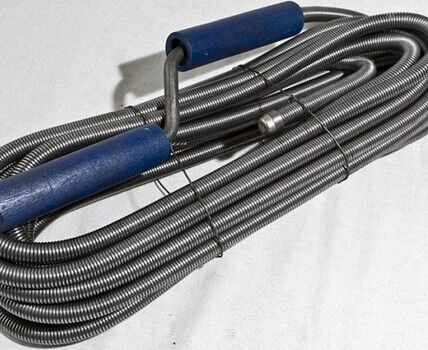
The basis for the manufacture of a spring-type cable is a rod wound with a strong steel non-galvanized wire having a cross section of 2 mm
With an increase in the diameter of the cable, the size of the wire used for its manufacture also increases:
- for products with a thickness of 10-12 mm, a metal cord D 1.4 mm is used;
- for cables of 14 mm - thread D 1.4 mm;
- for rods D 16 mm - wire D 2.1 mm.
Spring-type products, like their simpler counterparts described above, are equipped with a handle. But in models of this type, it performs the function of a tensioner. At the moment of rotation and tension, the spring acquires a special rigidity, due to which it easily destroys even the most difficult blockages.
In professional models used for long pipes, the handles are often made sliding. Due to this, they easily move along the length of the rod and are fixed in the desired position. Such a constructive solution avoids the cable twisting during operation.
Depending on the model, the equipment may be equipped with various types of nozzles. They are selected based on three parameters:
- pipe type;
- the material of their manufacture;
- design features (the presence of joints and knees).
To break through the crumbs from stone and sand, a bottom nozzle is used, to remove compressed blockages, a punching tip is chosen, and to extract lumps of dirt and old rags, nozzles in the form of loops and hooks are used.
Tool Selection Criteria
When choosing a product, it is necessary to probe and inspect it for mechanical damage. The cable should not have a memory for bending. Make sure the handle is securely fastened. Pay attention to the pipe. It should be a little springy and plastic.
All elements of the tool, including nozzles intended for impact, must be made only of high quality steel.
The main parameters that should be considered when choosing a plumbing cable:
- Device diameter. The size of plumbing cables on sale ranges from 6-18 mm. The required size of the rods is selected, focusing on the diameter of the laid pipes and the complexity of clogging.
- Design. The handle can be L- and Z-shaped. On sale there are handles equipped with a locking system. They are convenient in that they hold the rods and at the same time allow them to be rotated in any direction.
- Set of interchangeable nozzles. Among the variety of interchangeable nozzles on the market, the most popular are "harpoons", with which it is convenient to extract large elements of dense plugs, and reinforced punches that can break through the hardest blockages.
To work with sewer and drain pipes D 100 mm, made of plastic, choose rods with a diameter of 10-12 mm. Models of this size are indispensable even if the pipeline includes a large number of bends with an angle of more than 45 °.
If it is necessary to work with sewer pipes D 100-200 mm, which are long, choose tools D 14 mm. For pipes D 200 mm and more, tools with a diametrical size of 16 mm are used.
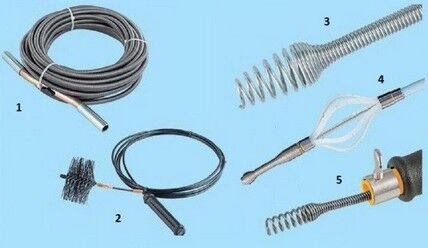
Included with the cable, you can also purchase a set of nozzles that will make the cleaning process easier and more effective.
Important point! If the first and last layers of the core are wound in the right direction along the axis, then this indicates that the cable is designed for right-hand rotation. In this direction, the tool has 2 more layers of wires than in the left side. And if you rotate the cable to the left, it will simply break.
If possible, you can purchase a cable with an electric drive.

Modifications with a combined electric drive, referred to as "turntables", have a number of auxiliary functions that greatly facilitate the task.
"Turntables" are able to quickly and effectively eliminate simple blockages at short and medium distances of sewer routes.
Rope Application Guide
Cleaning from clogged water and sewer pipes with a cable includes a number of basic steps.
Image Gallery

The main signs indicating that a blockage has formed are water slowly flowing into the drain hole, as well as the appearance of an unpleasant odor from the pipe.
Having determined the type of blockage formed and its location, prepare a tool with the appropriate nozzles to eliminate the problem.
The first stage involves preparing the cable for operation. To do this, the tool is inspected for integrity and performance. On the cable itself, it is necessary to check the strength and reliability of fixing the handle.
Before starting work, the floor must be covered with a film. Further manipulations are recommended to be carried out with protective gloves.
Clearing blockages
In order to properly clean the sewer, it is necessary to open free access to the socket of the outlet pipe. To do this, the first step is to remove the siphon. It has the shape of a curved pipe and is attached to the drain hole.
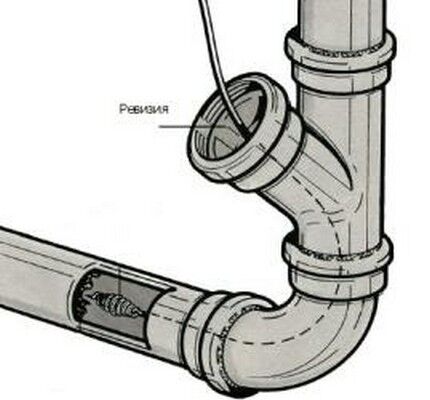
The place of connection of the siphon before launching into the cavity of the pipe of the tip of the steel tool is washed from the remnants of dirt with jets of hot water
The sequence of actions when working with the tool:
- Holding the rotary handle in the palm of your hand and fixing the main part of the cable in a coiled position in the form of a ring, the working end of the tool is inserted into the pipe hole.
- By making translational-rotational movements with the handle, they advance the device deep into the pipe and overcome difficult sections. The cable itself needs to be deployed only to the length required to clear the blockage.
- Having reached the place of blockage, by rotating the handles increase the force and increase the speed of advancement, trying to destroy the seal.
There are two ways to remove a mud plug: by pushing forward, after putting on a punch of a suitable size, or by removing it with a hook-hook. When making translational movements, you should not press the tool with force. This can damage the equipment and ruin the inside surface of the smooth plastic pipe.
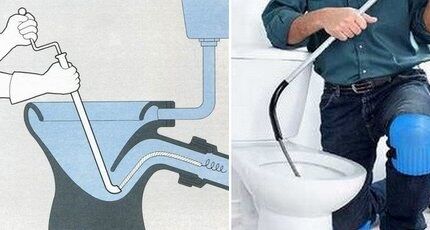
By performing translational-rotational movements, you will facilitate the smooth overcoming of the bends and knees present in the sewer system with a flexible rod
When guiding the cable and applying torque to it, rotational movements must be performed only in the clockwise direction. If you rotate the handle of the tool in the opposite direction, you can provoke the blooming of the flexible core.
In the process of passing obstacles, it is periodically necessary to pull the cable to the surface and clean it from the remnants of adhering dirt. The work is best done by two people, dividing the duties of rotating and pushing, alternating with cleaning the nozzle of the tool.
System health check
Noticing that the accumulated liquid begins to leave, empty the tank or open a tap with hot water. At first, it is better to supply water with low pressure. If everything goes smoothly, you can gradually increase the strength of the flow.
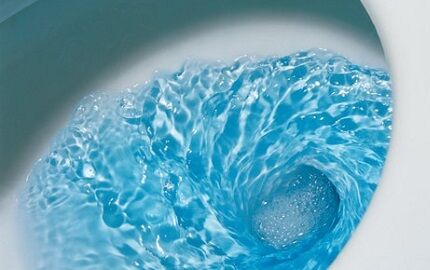
If, during a test run of water, an impromptu funnel is formed in the drain, this indicates that the problem has been completely eliminated
There are situations that during rotation the cable gets stuck in the pipe. In this case, the easiest way to solve the problem is to turn the tool to the left or right and at the same time lightly press on it.
General rules for the care of the device
The cable, like any other plumbing fixture, needs proper care. After each use, the tool must be washed under the pressure of water or in a filled container with the addition of a soapy solution. To prevent rust between the wire layers, the spring part of the tool must be regularly treated with machine oil.
In the future, if it is necessary to shorten the cable, the cut point will need to be pre-annealed by 10-12 cm.
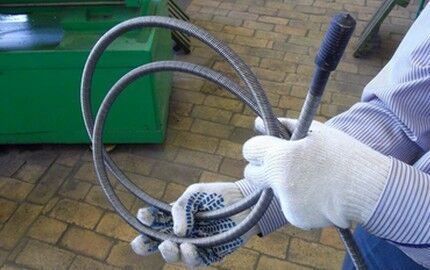
The convenience of turning the handle is ensured by the work of special bushings; the task of a zealous owner is not to forget to periodically lubricate them with used engine oil
The oil-treated cable is wiped dry with a piece of cotton fabric and rolled into a bay. In this position, it takes up a minimum of space, making it easy to place it in a corner under the bathroom or in a closet among the tools. With proper care, such equipment can properly serve the owner for more than two decades.
Conclusions and useful video on the topic
Overview of the main types of plumbing cables:
And finally, advice from the master. When cleaning, to soften the blockage and facilitate the movement of the tool, pour portions of hot water into the pipe, if possible. Otherwise, the procedure for cleaning the sewer with a cable should not cause any particular difficulties.



